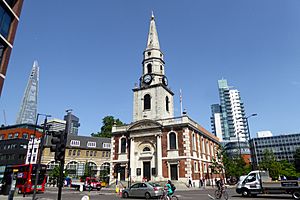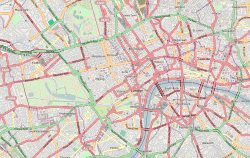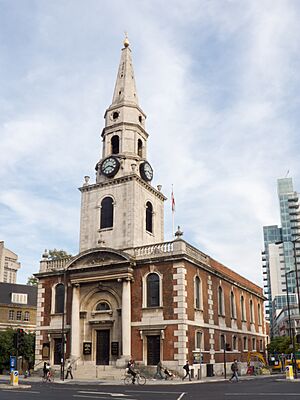St George the Martyr, Southwark facts for kids
Quick facts for kids St George the Martyr |
|
|---|---|

St George the Martyr looking south along Borough High Street
|
|
| 51°30′05″N 0°05′34″W / 51.501263°N 0.092671°W | |
| Location | The Borough, London Borough of Southwark |
| Country | England |
| Denomination | Church of England |
| Tradition | Anglican Catholic |
| Architecture | |
| Heritage designation | Grade II* |
| Architect(s) | John Price |
| Administration | |
| Diocese | Southwark |
St George the Martyr is a famous church located in the historic Borough area of south London. You can find it on Borough High Street in the London Borough of Southwark. The church is named after Saint George, a very important saint. It's also a special building, listed as Grade II*, which means it's historically important and protected.
The church has a strong connection to the famous writer Charles Dickens. His father was once held in the Marshalsea prison because of debt. A part of the prison wall is still next to the churchyard. Dickens himself lived nearby as a teenager. He even set parts of his novel Little Dorrit in and around St George's Church. You can see a small picture of Little Dorrit in one of the church's windows.
St George the Martyr is also a recognized church for the City of London's Company of Parish Clerks. It is also the guild church of the Guildable Manor. Since 2008, a special ceremony called the Southwark Quit Rents ceremony has been held here each year.
Contents
History of the Church
The Story of Saint George
Saint George was a soldier in the Roman Army. History says he was killed in the year 303. This happened because he refused to harm Christians and bravely said he was a Christian himself.
Early Beginnings
The first mention of a church in Southwark dedicated to Saint George was in 1122. This was after the Battle of Acre, when stories of Saint George became very popular. This church was the first one in Greater London named after Saint George. It was built over 200 years before King Edward III made Saint George the patron saint of the Order of the Garter.
Royal Connections
In 1415, King Henry V returned from his great victory at the Battle of Agincourt. The leaders of London welcomed him on the steps of St George's Church. The famous 'Agincourt Song' was created for this celebration. In that battle, the flag with the red Saint George's Cross was used for the first time. In the same year, Saint George became the patron saint of England.
Changes to the Church Building
The church you see today is believed to be the third one on this spot.
- The first church was built in the Norman style.
- The second church was built in the late 1300s. It had a bell tower.
- The current church was rebuilt between 1734 and 1736. It was designed in a Classical style by John Price. Money for the rebuilding came from a special commission and also from important City companies. Their coats of arms can still be seen inside the church.
The church's tall west tower stands out on Borough High Street. This is because the street curves right where the church is located.
Important Work in the 1800s
In 1852, a priest named William Cadman became the rector of St George the Martyr. At that time, it was one of London's largest parishes. When Cadman arrived, the church was often empty. He worked hard to bring the community back to the church. He encouraged volunteers and started schools in poor areas. During his time, new chapels and churches were built.
In 1899, the church's crypt (an underground room) was emptied. Many coffins were moved and reburied in Brookwood Cemetery in Surrey.
Surviving Through Challenges
The church's foundations were made stronger in 1938. This helped save the building during World War II, when London faced a lot of damage from bombs.
Over the years, the church's structure, made of red brick and Portland stone, suffered from sinking ground. In 2000, the main part of the church, the nave, was declared unsafe. However, services continued in other areas.
In 2005, St George the Martyr received money for repairs and improvements. This included strengthening the entire building. During these works, many old lead coffins were moved from the crypt. Archaeologists found old medieval and Roman structures beneath the church.
The church was closed for restoration from September 2005 to March 2007. During this time, the church community worshipped at nearby Guy's Chapel. The new "crypt" area, which is now a church hall, provides a new space for events. Services at St George's started again on Palm Sunday, April 1, 2007.
Church Design and Features
The church is built with red brick and Portland stone. It has a roof made of copper and slate. At the main entrance on the west side, there is a pediment (a triangular shape) supported by Ionic columns. This pediment has carvings of angels. Eight steps lead up to the entrance.
The church's tower is made of Portland stone and has a large spire on top. At the very top of the spire, there is a ball and a weather vane.
Inside the church, the main area, called the nave, has a gallery on three sides. The ceiling has a painting from 1897 by Basil Champneys. It shows angels breaking through clouds. You can also see the coats of arms of four important City companies on a decorative band.
The chancel (the area around the altar) has three sections. There is a tall pulpit (where sermons are given) supported by four Ionic columns. The church also has an octagonal font made of grey marble.
The east window of the church is special. It includes a kneeling figure of Amy Dorrit, a character from Charles Dickens' novel. This window was designed by Marion Grant.
Like some other churches in London, St George the Martyr has two carvings of the Royal Arms. Both are from the House of Stuart period. The main one is on the gallery at the west end. It is believed to have come from another old church.
See also





